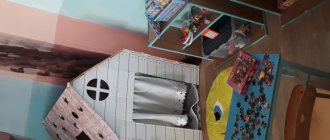Circle games 3
"Movement in a circle."
Everyone stands in a circle. The first one starts - shows the movement. The second one picks it up, then the third one, etc. in a circle. When it's the first person's turn, he changes the movement, and everyone continues to repeat the first. When the first one changes, the second one changes the movement, then the third one, and so on until the first one, who again changes the movement.
"Giraffe - elephant - bird."
Everyone stands in a circle. The driver suddenly points at someone and says one of three words (giraffe, elephant, bird). If the word “giraffe” is pronounced, then this player raises both hands up, and his two neighbors - on the right and on the left - must squat down. This is how they depicted a giraffe. If “elephant”: the player makes a trunk out of his hands, and the players on the right and left make ears to it. If it is a “bird”, the player himself makes a beak out of his hands, and the neighbors bend one leg farthest from the player and move their arm to the side. A player who hesitates or makes the wrong piece is eliminated from the game.
"The Hare and the Fox."
Everyone stands in a circle. Two items are taken. One is a “hare”, the other is a “fox”. The “fox” must catch the “hare” (two objects from one person), and the “hare” must run away. The game begins. When the player comes across one of the items, he decides: to help the hare escape or to help the fox catch the hare. To do this, he sends a “hare” and a “fox” in one direction or another. It’s interesting to watch how the game plays out and who “helps” whom.
“The bull is walking and rocking.”
To the verses of Agnia Barto “The bull walks and sways” (1st quatrain), the players walk in a circle with a simple step. Then, repeating the same quatrain, everyone walks in the opposite direction, bending their knees and placing their hands on their shoulders. Repeat again, turn around, new position of the arms and legs - more complex, and so on until the game gets boring.
"Lavata".
Everyone stands in a circle. Holding hands, they walk in a circle with the words: We dance together, tra-ta-ta, tra-ta-ta, our cheerful dance - was that lavata? Were those hands? Were! Were there ears? No! My ears are good, but my neighbor's are better! Everyone grabs the ears of the outermost neighbors. They walk in a circle with the same words, adding: Were there ears? Were! Were there noses? No! My nose is good, but my neighbor's is better! So the game continues.
"A swan was flying."
Everyone stands in a circle. The right hand lies on the palm of the left hand of the left neighbor. And on the left hand lies the right hand of the left neighbor. With each word it hits the hand (in a circle). Words: “A swan flew across the blue sky and thought of a number, for example:...” The player names the number. The counting begins until this number. On the last number, the player must have time to hit the palm of the left neighbor lying on his left hand, and he must have time to remove it. Those who do not have time are eliminated.
"Mail".
Children stand in a circle, holding hands. Naked in the middle of the circle. At the choice of the presenter, one of the children says the phrase: “I pass on the letter (and says the name of one of the children standing in the circle).” Then he shakes his neighbor’s hand with one. Children shake hands along the chain. As soon as they shake the hand of the player to whom the letter was given, he must say: “I received the letter.” Only after this does he receive the right to transmit the letter. The recipient must notice the moment of the handshake and indicate: “Here.” If he is right, then the child who gave the handshake becomes the driver, and the driver takes his place and gets the right to hand over the letter. Game continues.
"Santiki - santiki - lim - po - po."
The players stand in a circle. The driver moves away from the circle for a few seconds. At this time, the children in the circle agree upon whom everyone will repeat the movements (clapping their hands, stamping their feet, patting them on the head). The driver returns to the circle. His task is to determine who shows all the movements. Throughout the game, the words are pronounced in chorus: “Santiki - santiki - lim - po - po.” The task of the “shower” is to change movements imperceptibly, and everyone must immediately adopt it. Three attempts to guess. If you guess right, they change places.
"To my neighbor."
Children stand in a circle. The left hand is held with the palm extended forward, and the right hand palm down. When they say “to themselves,” the children use their right hands to seem to be putting something into their left hand. In response to the words “neighbor,” they make a movement with their right hand, as if putting something into the left hand of a neighbor standing on the right side.
Everyone simultaneously says: “to oneself - to a neighbor” and performs the movement. A small object (coin or ring) is passed around the circle. The driver, standing in the center of the circle, must notice who has the item, then he and the player who has the item change places.
Game "You - Me."
Everyone stands in a circle. Everyone takes a small thing in their hand. The game begins. First, the player turns to the left neighbor, offering his item, naming it. And then to the right side, asking: “Huh?” This is done three times. Moreover, all these actions are performed by all players at the same time. After this, the item is given to the left neighbor and a new one is taken from the right neighbor. And the same operation is repeated. The game continues until everyone gets their item back.
"Pace".
All players sit in a circle. Players settle in numerical order and remember their numbers. The presenter sets the pace: two claps on the knees, two snaps of the fingers. Everyone repeats. As soon as a single rhythm can be established, words are introduced. Hitting the knees twice, the presenter says his number “one, one” twice and makes two clicks with his fingers. Then, clapping his knees for the first time, he says his number, after the second clap, he says the number of the player to whom he passes the word (for example: “one, three”). Now this player (numbered “3”), without leaving the general tempo, plays the game. It is advisable at the beginning of the game to simply pass the word one by one so that the players remember the tempo and rules of the game, and then do it at random, gradually speeding up the pace.
"Uncle Abram's."
Uncle Abram has twelve sons, Uncle Abram has twelve sons. They did not eat, did not drink and were never bored. Right hand.
Everyone walks in a circle, shaking their hands and repeating the same words. Then different parts of the body are added with different movements (left arm, right leg, left leg, right shoulder, left shoulder, head, etc.). All movements are repeated simultaneously.
"Guess the movement."
The driver comes out. Everyone thinks of any movement, for example: sit down. Then the driver comes in. His task is to guess the intended movement or action. He starts making any movements, and everyone says “warm” or “hot,” and so on until he guesses right.
“Puffs - snorts.”
Children stand in two circles (the inner one - “pyfki” and the outer one - “fyfki”) facing the center of the circle, forming pairs (the players in the inner circle stand with their backs to their partners). It is advisable that one circle is made up of girls and the other is made up of boys. The number of people in the outer and inner circles should be the same. At the command of the leader: “pyfki” - the players in the inner circle must change places, taking the place of a free player in the outer circle (“fyfki”), without taking the places of their closest neighbors. At the command “fyfki,” the players in the outer circle change places. The presenter strives to be the first to take an empty seat. The player left without a pair becomes the leader.
"I'm not a slowdown." Everyone stands in a circle. They are counted in order, remembering their number. The driver in the center calls two numbers from the available ones. The two whose numbers were called must switch places. The driver must have time to take the vacant seat. Whoever does not get a seat becomes the driver. He stands in the center of the circle and says: “I’m not a brake.” And everyone else answers: “We noticed.” And the game continues.
Cone (“set up your neighbor”)
All participants stand in a circle. The leader goes to the middle of the circle. In his hands he holds a cone rolled up from paper. The leader points the cone at any person from the circle, and this person names the name of any other participant in the game (except for the leader). The presenter’s task is to find in the circle the person whose name was named. The faster, the more interesting.
Compliments (we show our knowledge of each other’s personality)
The participants of the game sit in a circle. One of them has a ball. He gives a compliment to one of the participants in the game (addressing him by name) and throws him a ball, etc. Moreover, it is important that this compliment be true about this person, because during the dating games we have already gotten to know each other a little. This game can be done by complimenting the person sitting next to you and passing the ball around in a circle.
“We walk around” (for small ones)
The participants of the game form a circle. Inside the circle is the leader. The players move slowly and sing:
We walk around each other, Hey guys, don't yawn! Everything that Kolya (Nina) shows us, We will repeat together!
The presenter shows movements, for example, how a frog jumps, claps its hands, spins in place, etc. The players repeat his movement as accurately as possible. Then the presenter approaches any player and bows low. He becomes the leader and the game continues
Catch the ball"
Everyone stands in a circle. They take each other's arms and extend their palms forward. Throwing a ball (bag) around in a circle
1. pass it on to a neighbor 2. through one person 3. through two people.
If the ball falls, the game starts again.
"Endless Ring"
A ring is made from rope. Everyone stands in a circle. without releasing your hands, you need to pass the rope over all the players (you need to crawl into the rope - you can’t help with your hands and teeth)
Count to 10
“Now, at the signal “start,” you will close your eyes, lower your noses down and try to count from one to ten. But the trick is that you will count together. Someone will say “one”, another person will say “two”, a third will say “three” and so on... However, there is one rule in the game: only one person must say the word. If two voices say “four,” the count starts over. Try to understand each other without words.” did the group manage to do it? If yes, then how? If it didn't work out, then why? What was stopping you? Who took an active part, who remained silent?
Virtual gift
Everyone stands in a circle. Everyone takes turns coming up with a gift for their right neighbor and silently gives it, pretending to give it as if they were giving a real gift. After the general gifting, everyone guesses what they were given.
Wider, wider circle, I have 500 friends
Participants join hands in a circle (according to the principle: boy and girl). The driver comes into the center of the circle, closes his eyes and extends his arms (arrow) in any direction. The circle begins to move clockwise, and the driver begins to move in the opposite direction. As they move, everyone repeats the words in chorus: “Wider, wider circle, I have 500 friends.” This one, this one, this one, and my favorite one is this one.” Everyone stops. The player of the opposite sex, whom the driver pointed to when stopping, goes to the center of the circle. These players stand with their backs to each other and close their eyes, and the rest of the participants begin to count to three in unison. On the count of three, the players in the center turn their heads in any direction. If they turn in one direction, they kiss on the cheek; if not, they shake hands.
A variation of this game is “Shirshe, shirshe, shirshe kolo.” The child walks in a circle and repeats: “Wider, wider, wider, there are a lot of friends here.” Tsya, tsya, tsya, and if you’re in love, it’s the axis of tsya.” Then the principle is the same.
You can play the same game, but repeat “aram-shim-shim, aram-shim-shim, aramia-dulsia - point to me!” And one, and two, and three!”





